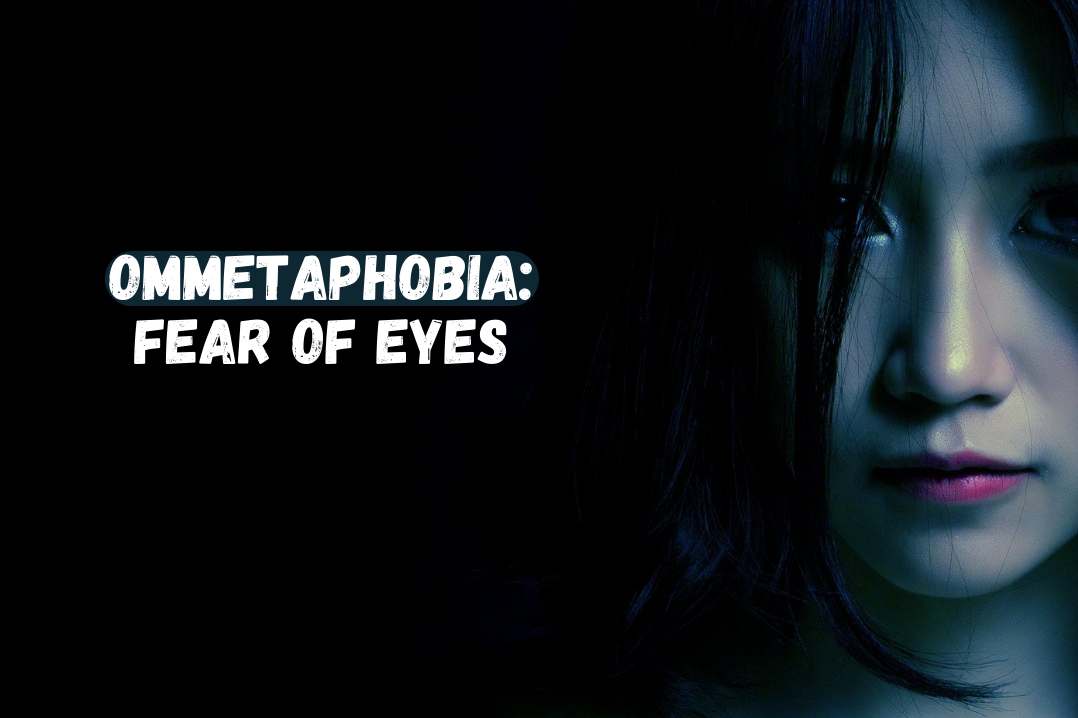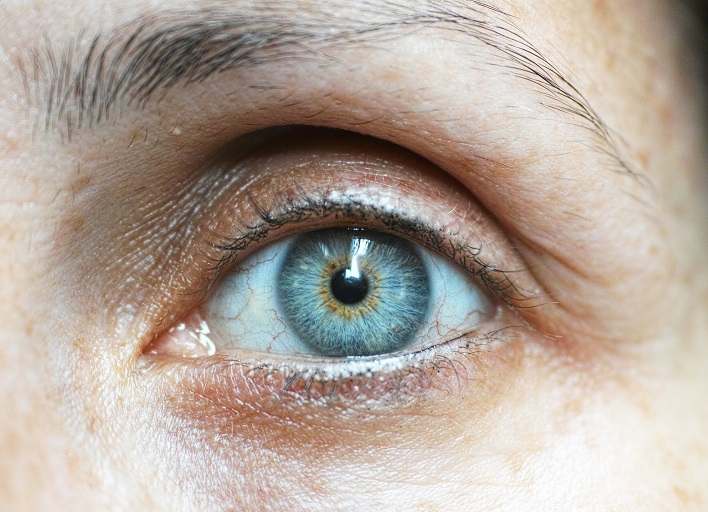
Ommetaphobia, the irrational fear of eyes, can induce intense anxiety merely at the thought of eyes and can even trigger panic attacks in some cases. While not everyone with Ommetaphobia will experience panic attacks, the possibility remains quite plausible.
When a panic attack does occur, it typically entails an elevated heart rate, rapid breathing, increased blood pressure, muscle tension, trembling, and excessive sweating, among other symptoms. These physical manifestations of anxiety can be distressing for the individual.
Individuals afflicted by Ommetaphobia often resort to avoidance behavior as a coping mechanism. This extreme avoidance can manifest in various ways, such as refusing to make eye contact during conversations. Paradoxically, while avoidance may offer temporary relief, it can exacerbate the phobia in the long term by reinforcing the fear through justification.
It’s important to recognize that Ommetaphobia is rooted in irrational thinking, and seeking professional help is essential to effectively address and manage this specific phobia.
Ommetaphobia
Ommetaphobia, derived from the Greek words “omma” (eye) and “phobos” (fear), is a specific phobia characterized by an intense and irrational fear of eyes. While it may seem peculiar to some, those who suffer from this condition experience genuine distress and anxiety when confronted with anything related to the eyes. Understanding the root causes of Ommetaphobia is essential in addressing this fear effectively.
Root Causes

Traumatic Events: Traumatic incidents involving eyes can leave a profound impact on an individual. Witnessing an eye injury, whether it’s a workplace accident or a sports-related mishap, can be a triggering event. Additionally, undergoing a distressing eye-related medical procedure, such as eye surgery or treatment for an eye condition, can imprint the fear of eyes. The emotional intensity of such events can lead to a deep-seated association between eyes and fear.
Childhood Experiences: Early childhood experiences hold significant sway over an individual’s emotional development. In the context of Ommetaphobia, witnessing someone close, such as a family member or friend, experiencing eye-related trauma during formative years can be particularly influential. These early memories can create a lasting imprint, reinforcing the fear of eyes as something inherently distressing.
Genetics: While the precise genetic underpinnings of Ommetaphobia remain a subject of ongoing research, there is evidence to suggest a genetic predisposition to phobias in general. Some individuals may inherit a heightened vulnerability to anxiety disorders and specific phobias like Ommetaphobia from their family lineage. This genetic predisposition can make certain individuals more susceptible to developing Ommetaphobia when exposed to triggering events or stimuli.
Ommetaphobia is a complex condition with multiple contributing factors. Traumatic events, early experiences, and genetic predisposition collectively shape an individual’s susceptibility to this fear of eyes. Understanding these root causes is vital for both individuals and mental health professionals working towards effective treatment and management strategies.
Symptoms

Panic Attacks: One of the hallmark symptoms of Ommetaphobia is the potential for panic attacks. When confronted with stimuli related to eyes, individuals with Ommetaphobia may experience intense and overwhelming panic attacks. These can be triggered by various eye-related situations, including viewing images or videos of eyes, as well as encountering actual eyes in person. During a panic attack, they might exhibit symptoms like rapid heartbeat, shortness of breath, chest pain, a sense of impending doom, and a feeling of losing control. These attacks can be distressing and may lead to a strong desire to escape the triggering situation.
Avoidance Behavior: Ommetaphobia often leads individuals to engage in avoidance behavior as a coping strategy. They may go to great lengths to evade situations where they might come into contact with eyes. This can extend to avoiding eye contact during conversations, which is a common behavior among those with this phobia. Such avoidance is an attempt to reduce immediate anxiety, but it can also have detrimental effects on an individual’s social and professional interactions in the long term.
Physical Symptoms: In addition to the psychological distress experienced, Ommetaphobia is associated with various physical symptoms. These may include a rapid and irregular heartbeat, profuse sweating, trembling or shivering, muscle tension, and a feeling of nausea. These physical manifestations of anxiety often accompany the emotional distress triggered by exposure to eye-related stimuli.
Recognizing these symptoms is crucial for both the individual and mental health professionals when it comes to diagnosing and effectively addressing Ommetaphobia. Early intervention and treatment can help individuals regain control and alleviate the distress caused by this specific phobia.
Treatment

Exposure Therapy:
While there are no specific treatments tailored exclusively for Ommetaphobia, various methods can effectively alleviate its symptoms. Exposure therapy is a common and highly beneficial approach for people grappling with phobias. This therapy involves a gradual process where a therapist exposes the patient to their fear over a specified period. In the context of Ommetaphobia, the therapist starts with mild exposure, such as showing photos of eyes, and progressively advances to more challenging stimuli like videos of eyes. The goal is to desensitize the patient by repeated exposure, with the theory that the more an individual confronts their fear, the less distressing it becomes over time.
Cognitive Behavioral Therapy (CBT):
CBT, a versatile treatment modality, is frequently employed to help individuals with various anxiety disorders, including generalized anxiety disorder and obsessive-compulsive disorder. It can also be effective in treating phobias like Ommetaphobia. CBT involves the therapist assisting the patient in understanding the underlying reasons for their thoughts, emotions, and behaviors related to their specific fear. Through CBT, individuals with Ommetaphobia can gain insight into the origins of their apprehension about eyes. This understanding empowers them to take a more rational and pragmatic approach when dealing with their fear.
Mindfulness-Based Stress Reduction (MBSR):
MBSR is an evidence-based, 8-week program designed to offer intensive mindfulness training to individuals experiencing anxiety, stress, depression, and other forms of mental distress. Mindfulness meditation, a core component of MBSR, has proven to be beneficial for anxious individuals, including those with Ommetaphobia. Participants in MBSR programs learn a range of mindfulness techniques aimed at relieving the intense anxiety associated with their specific phobia.
Meditation:
Meditation, particularly mindfulness meditation, can be a valuable tool for those suffering from Ommetaphobia. Mindfulness meditation aids individuals in achieving a state of equanimity by redirecting their focus away from their fear and towards neutral or calming stimuli. This practice is especially beneficial during panic attacks, as it can help reduce the mental distress associated with heightened anxiety. Mindfulness meditation involves focusing on various sensory experiences, such as the sensations of breathing, sounds, tactile sensations, taste, and smell. Practicing mindfulness can effectively reduce anxiety related to Ommetaphobia. Keep in mind that becoming proficient in meditation requires consistent practice.
Exposure Therapy Caution:
When applying exposure therapy, it is vital for the therapist to gauge the patient’s level of fear and exposure tolerance accurately. Exposure should be tailored to the severity of the phobia. Underexposure may lead to limited progress, while overexposure can potentially worsen the condition. Therapists need to have a comprehensive understanding of the patient’s symptoms to ensure the therapy is effective and does not inadvertently exacerbate their phobia.
These treatment options offer individuals with Ommetaphobia a range of strategies to manage their symptoms and work towards overcoming their fear of eyes. It is strongly recommended to consult with a mental health professional to determine the most appropriate treatment approach based on the individual’s specific needs and circumstances.
Excercise:
Exercise is a valuable and proven method for managing anxiety disorders, including Ommetaphobia. Specifically, cardiovascular exercise can be particularly effective in alleviating stress and anxiety. While weight-resistance training can offer benefits, aerobic exercise is known to stimulate the release of feel-good chemicals in the brain, such as endorphins, which play a crucial role in reducing anxiety.
According to the American Psychological Association, exercise can condition the mind to better cope with stress. This adaptation occurs as the body undergoes considerable stress during strenuous physical activity. Therefore, if you find yourself leading a sedentary lifestyle, engaging in aerobic exercise can potentially provide significant relief from the symptoms of Ommetaphobia by enhancing your ability to manage anxiety and stress associated with this condition.
There is a wide range of aerobic activities that you can choose from to help alleviate the symptoms of Ommetaphobia. These activities include swimming, biking, skiing, walking, and jogging. Alternatively, you can enjoy the benefits of exercise by participating in sports like tennis, soccer, basketball, and racquetball, among many others.
Consistent engagement in some form of aerobic exercise may gradually reduce the distress associated with Ommetaphobia over time. Exercise not only contributes to physical well-being but also supports mental health, making it a valuable component in the management of anxiety and phobias. Remember that starting any exercise regimen should be discussed with a healthcare professional, especially if you have underlying health conditions.
Yoga:
Yoga offers numerous poses and practices that can significantly benefit individuals struggling with Ommetaphobia. The meditative aspect of yoga, where the mind is brought into a state of focus and tranquility, can be particularly helpful for managing the anxiety associated with this phobia. Yoga can be described as a form of “meditation in motion,” making it an effective tool for redirecting attention towards more productive and calming thoughts.
Various types of yoga are available, and someone with Ommetaphobia can choose the one that suits them best. Options include Hatha yoga, hot yoga, and many others. Regardless of the specific style, yoga is generally effective in alleviating the stress and anxiety associated with Ommetaphobia.
If you’re new to yoga, it’s advisable to consider taking a class or following guided videos that lead you through each pose. Similar to meditation, regular practice enhances your proficiency. Beyond reducing Ommetaphobia symptoms, you can also expect to gain increased strength and flexibility, along with a range of other physical and mental health benefits. Incorporating yoga into your routine can be a valuable step towards managing this specific phobia.
Reducing Caffeine Intake for Ommetaphobia:
It’s well-established that consuming excessive caffeine throughout the day can contribute to heightened anxiety. This connection becomes clearer when we delve into how caffeine affects our body’s physiology. When we ingest substantial amounts of caffeine, our heart rate increases, and we tend to become more tense. Essentially, our body shifts into a “fight or flight” state of arousal. For individuals with Ommetaphobia, this heightened state of alertness can often serve as a trigger for panic attacks.
Therefore, limiting or completely avoiding caffeine intake during the day may significantly help in reducing your daily anxiety levels. While it may not eliminate all anxiety, it can certainly mitigate unnecessary distress that might arise from consuming large quantities of caffeine.
Common sources of caffeine include coffee, tea, and certain energy drinks, with some foods like dark chocolate also containing caffeine. Being mindful of your daily caffeine consumption can be a practical step in alleviating some of the symptoms associated with Ommetaphobia.
Dialectical Behavior Therapy (DBT) for Ommetaphobia:
DBT is a highly effective form of treatment primarily designed to help individuals with emotion regulation, and it is often used to treat conditions like borderline personality disorder. However, its array of coping skills can be highly advantageous for individuals dealing with anxiety disorders, including Ommetaphobia. In a DBT group, participants can expect to gain valuable coping strategies over the course of approximately six months, with group sizes varying from just a couple of people to several, depending on how many individuals join the group.
One particularly effective DBT skill for individuals with Ommetaphobia is known as “half-smiling.” This technique involves thinking about the object of your fear or what upsets you while gently raising the corners of your mouth, creating a subtle smile—hence the term “half-smiling.” However, it’s not just about thinking of your fear while half-smiling; it also entails refraining from getting entangled in the distressing emotions that your specific fear may trigger.
Mindfulness meditation is another integral component of DBT and can provide substantial benefits for individuals with Ommetaphobia. Practiced within a group setting, it can help participants step out of their comfort zone. Group mindfulness exercises may include activities such as savoring the taste and tactile sensations of warm tea or simply focusing on one’s breath.
“Coping ahead” is another valuable DBT skill that can assist individuals with Ommetaphobia. In this practice, one finds a quiet, distraction-free place, closes their eyes, and envisions various scenarios in which they confront their specific fear and either overcome it or effectively cope with it. This exercise prepares individuals to be better equipped at managing Ommetaphobia when confronted with the fear in real-life situations.
Psychiatric Medications for Ommetaphobia:
Anti-anxiety Medications
Anti-anxiety medications play a crucial role in preventing panic attacks, which can be especially beneficial for individuals dealing with severe Ommetaphobia, as phobia sufferers often experience panic attacks. Common anti-anxiety medications include Xanax, Valium, Klonopin, and various others.
These medications are typically not meant for daily use but can be considered for individuals with severe Ommetaphobia. However, it is essential to discuss their usage with a healthcare professional to ensure safety and effectiveness.
Antidepressants
Antidepressant medications, although primarily prescribed for depression, can also be valuable in managing anxiety disorders, including Ommetaphobia. Common antidepressants such as Paxil, Zoloft, and Lexapro can assist in reducing the symptoms associated with Ommetaphobia.
Antidepressants are typically taken on a daily basis and are effective in not only preventing panic attacks but also in reducing daily anxiety levels. Consult with your doctor to determine if incorporating antidepressants into your treatment plan can help alleviate Ommetaphobia symptoms and whether it is a safe option for you.
Family and Social Support
Family and social support play a pivotal role in the process of dealing with Ommetaphobia. This section delves deeper into the ways in which these support systems can be not only beneficial but transformative:
Family Understanding:
Educating your family about Ommetaphobia is a crucial first step. By explaining the nature of your fear and its impact on your life, you can help your loved ones gain a better understanding of your experience. When your family understands the challenges you face, they can provide emotional support and create a safe and empathetic environment for you.
Open Communication:
Encourage open communication with your family. Discuss your feelings, fears, and the progress you’re making in managing Ommetaphobia. Sharing your journey with them can strengthen your emotional bonds and alleviate the sense of isolation that often accompanies phobias.
Supportive Role:
Invite your family to play a supportive role. This can include accompanying you to therapy sessions or helping you engage in exposure exercises. Their presence can provide comfort and encouragement during challenging moments.
Social Support Groups:
In addition to your family, consider joining support groups or online communities that focus on phobias, including Ommetaphobia. Connecting with individuals who are facing similar challenges can be reassuring. These groups provide a space to share experiences, exchange coping strategies, and receive valuable insights from those who understand what you’re going through.
Sharing and Learning:
Actively participate in these support groups. Share your experiences, the progress you’ve made, and the strategies that have been effective for you. Likewise, be open to learning from others who have successfully managed their phobias. The exchange of knowledge and support within these communities can be immensely valuable.
Professional Guidance for Loved Ones:
If Ommetaphobia has a significant impact on your relationships, encourage your family members to seek professional guidance as well. A therapist can provide them with the tools and insights needed to support you effectively. When your family and loved ones are equipped with the knowledge to assist you, it can create a more harmonious and understanding environment.
Setting Realistic Goals
Setting and achieving realistic goals is a fundamental aspect of managing Ommetaphobia. Here’s a closer look at how these goals can be instrumental in your journey:
Gradual Exposure:
Collaborate with your therapist to establish a gradual exposure plan. This plan involves systematically exposing yourself to eye-related stimuli in a controlled and supportive environment. The goal is to desensitize yourself to the fear over time. Through carefully structured steps, you’ll become more comfortable with eye-related triggers.
Daily Challenges:
Incorporate daily challenges into your life. These challenges can involve progressively confronting your fear. Start with manageable tasks, such as viewing images or videos of eyes, and gradually progress to more complex situations, like maintaining brief eye contact during conversations.
Measuring Progress:
Monitor your progress meticulously. Keep a record of the tasks you’ve undertaken, your emotional responses, and the duration of exposure. Acknowledge and celebrate even the smallest victories along the way. Recognizing your achievements, no matter how minor they may seem, can serve as a powerful motivator to continue facing your fear.
Long-Term Management
Effective management of Ommetaphobia is not a one-time endeavor but an ongoing process. Here are essential considerations for the long-term:
Stay Committed:
Consistency is paramount. Maintain a dedicated commitment to practicing coping strategies and attending therapy sessions. The more you invest in the process, the more significant the results you can achieve over time.
Regular Check-Ins:
Periodically consult with your mental health provider to assess your progress and make any necessary adjustments to your treatment plan. These check-ins ensure that your approach remains aligned with your evolving needs.
Lifestyle Choices:
Recognize the interconnectedness of physical and mental well-being. Maintain a healthy lifestyle that includes balanced nutrition, regular exercise, and stress-reduction practices. These lifestyle choices can have a positive impact on your overall mental health and enhance your ability to manage Ommetaphobia.
Conclusion
In conclusion, Ommetaphobia, like any phobia, presents its unique set of challenges. However, with the right approach and support systems in place, it is manageable and even treatable. By seeking professional help, implementing effective coping strategies, involving your support network, and setting and achieving realistic goals, you can work towards reducing the impact of Ommetaphobia on your life and ultimately regaining control over your fears.
It’s important to remember that everyone’s journey is unique, and progress may take time. Be patient and kind to yourself throughout the process, celebrating your successes and seeking support when needed. Overcoming Ommetaphobia is not only possible but a testament to your resilience and determination in the face of fear.
Reference
- Korgeski, G. (2009). The Complete Idiot’s Guide to Phobias: Everything You Need to Know About Irrational Fears—and How to Cope with Them. Penguin.
FAQs
1. What are some common triggers for Ommetaphobia?
Common triggers for Ommetaphobia include close-up images of eyes, eye contact during conversations, and even eye-related medical procedures. Anything associated with eyes can potentially provoke anxiety in individuals with this phobia.
2. Can Ommetaphobia develop later in life, or is it primarily a childhood phobia?
While Ommetaphobia often originates from childhood experiences, it can develop at any stage of life. Traumatic events or distressing encounters with eyes in adulthood can also lead to the development of this specific phobia.
3. Are there self-help strategies for managing Ommetaphobia?
Yes, some self-help strategies can aid in managing Ommetaphobia. These may include relaxation techniques, mindfulness practices, and controlled exposure to eye-related stimuli. However, seeking professional guidance is usually more effective in addressing this fear comprehensively.
4. Is Ommetaphobia a rare phobia?
Ommetaphobia is relatively uncommon compared to more widely known phobias. However, it is not extremely rare, and many individuals around the world experience this fear. Its prevalence may be underreported due to the private and sensitive nature of the phobia.
5. Can Ommetaphobia affect daily life and relationships?
Yes, Ommetaphobia can significantly impact daily life and relationships. Avoidance of eye contact, social situations, or even specific occupations can lead to personal and professional challenges. Seeking treatment can help individuals regain control and lead more fulfilling lives.
